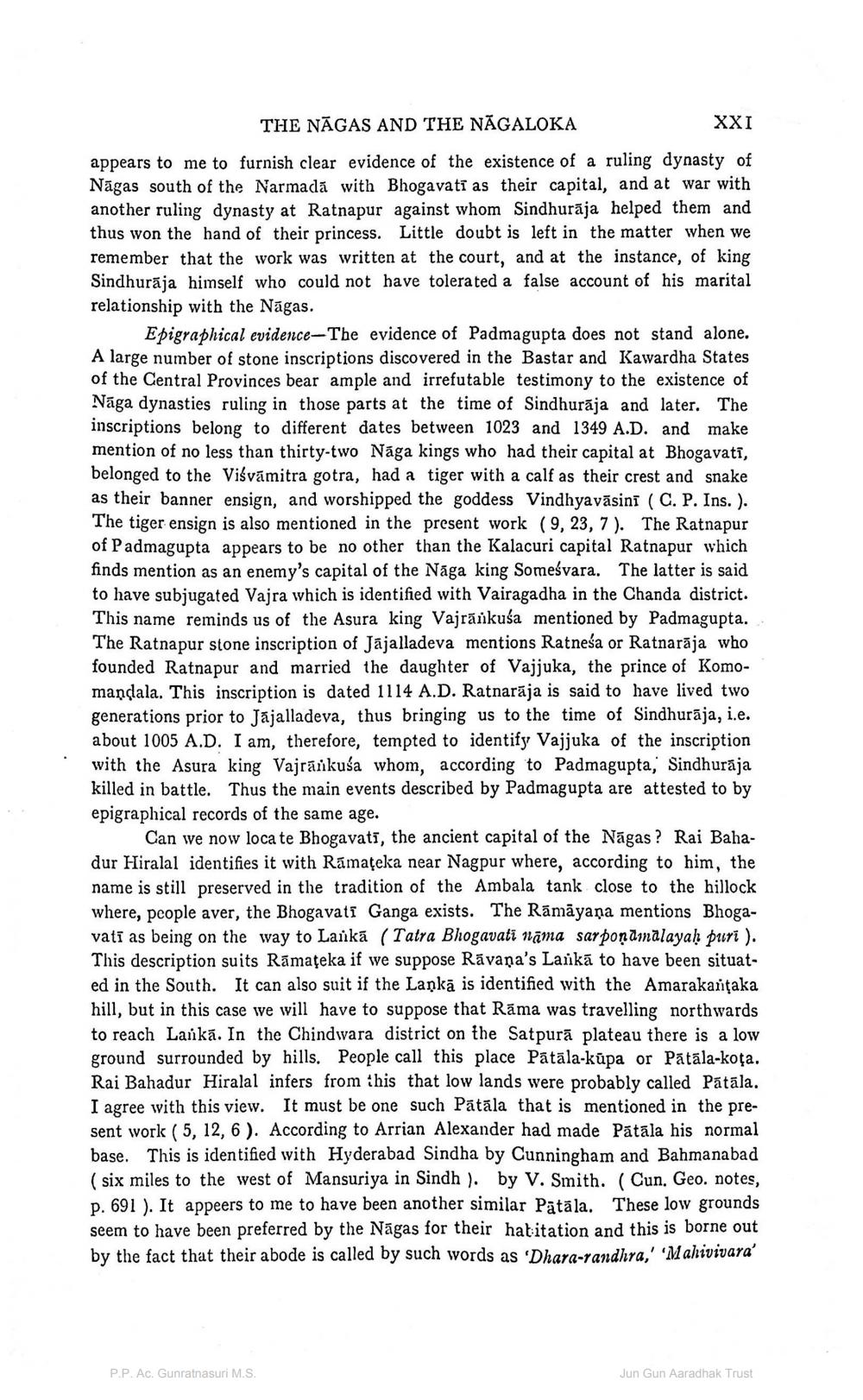________________ THE NAGAS AND THE NAGALOKA XXI appears to me to furnish clear evidence of the existence of a ruling dynasty of Nagas south of the Narmada with Bhogavati as their capital, and at war with another ruling dynasty at Ratnapur against whom Sindhuraja helped them and thus won the hand of their princess. Little doubt is left in the matter when we remember that the work was written at the court, and at the instance, of king Sindhuraja himself who could not have tolerated a false account of his marital relationship with the Nagas. Epigraphical evidence- The evidence of Padmagupta does not stand alone. A large number of stone inscriptions discovered in the Bastar and Kawardha States of the Central Provinces bear ample and irrefutable testimony to the existence of Naga dynasties ruling in those parts at the time of Sindhuraja and later. The inscriptions belong to different dates between 1023 and 1349 A.D. and make mention of no less than thirty-two Naga kings who had their capital at Bhogavati, belonged to the Visvamitra gotra, had a tiger with a calf as their crest and snake as their banner ensign, and worshipped the goddess Vindhyavasini (C. P. Ins. ). The tiger ensign is also mentioned in the present work (9, 23, 7). The Ratnapur of Padmagupta appears to be no other than the Kalacuri capital Ratnapur which finds mention as an enemy's capital of the Naga king Somesvara. The latter is said to have subjugated Vajra which is identified with Vairagadha in the Chanda district. This name reminds us of the Asura king Vajraukusa mentioned by Padmagupta. The Ratnapur stone inscription of Jajalladeva mentions Ratnesa or Ratnaraja who founded Ratnapur and married the daughter of Vajjuka, the prince of Komomandala. This inscription is dated 1114 A.D. Ratnaraja is said to have lived two generations prior to Jajalladeva, thus bringing us to the time of Sindhuraja, i.e. about 1005 A.D. I am, therefore, tempted to identify Vajjuka of the inscription with the Asura king Vajraukusa whom, according to Padmagupta, Sindhuraja killed in battle. Thus the main events described by Padmagupta are attested to by epigraphical records of the same age. Can we now loca te Bhogavati, the ancient capital of the Nagas ? Rai Bahadur Hiralal identifies it with Ramateka near Nagpur where, according to him, the name is still preserved in the tradition of the Ambala tank close to the hillock where, people aver, the Bhogavati Ganga exists. The Ramayana mentions Bhogavati as being on the way to Laika (Tatra Bhogavati nama sarponamalayah puri ). This description suits Ramateka if we suppose Ravana's Laika to have been situated in the South. It can also suit if the Lanka is identified with the Amarakantaka hill, but in this case we will have to suppose that Rama was travelling northwards to reach Lanka. In the Chindwara district on the Satpura plateau there is a low ground surrounded by hills. People call this place Patala-kupa or Patala-kota. Rai Bahadur Hiralal infers from this that low lands were probably called Patala. I agree with this view. It must be one such Patala that is mentioned in the present work ( 5, 12, 6). According to Arrian Alexander had made Patala his normal base. This is identified with Hyderabad Sindha by Cunningham and Bahmanabad ( six miles to the west of Mansuriya in Sindh ). by V. Smith. (Cun. Geo. notes, p. 691 ). It appeers to me to have been another similar Patala. These low grounds seem to have been preferred by the Nagas for their habitation and this is borne out by the fact that their abode is called by such words as 'Dhara-randhra,' Mahivivara' P.P.AC. Gunratnasuri M.S. Jun Gun Aaradhak Trust




